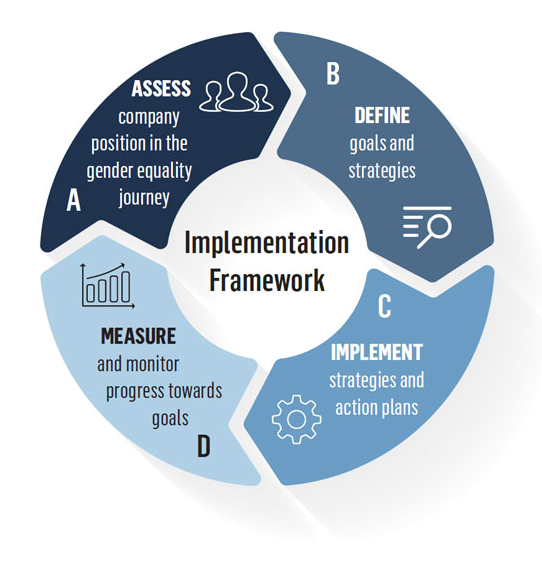Advance performance through a focused framework to implement gender equality in your company

The Blueprint is a comprehensive, actionable roadmap designed to guide and assist organizations looking to improve workplace gender equality.
What Is the Blueprint?
The Blueprint
By using the Blueprint with guidance from the Roadmap, the private sector can achieve gender equality leadership.
Gender Equality Leadership: A workplace with gender equality at its core is inclusive, empowering, and guarantees safety, wellbeing, and equality of opportunity while ensuring that all employees are respected and valued.
A Roadmap for Gender Equality: Gender equality in the workplace can only be achieved when bold and visible leadership ensures an inclusive environment, documented by transparent and effective accountability measures. All three cornerstones – Leadership, Inclusion, and Transparency and Accountability – must exist and function together to support progressive action and ensure a workplace with gender equality at its core.
The Business Case: Gender Equality Means Business
Organizations that employ more women throughout the pipeline – between 30 and 60 percent – tend to outperform their competitors in return on sales, EBIT margins, stock price growth, return on capital, return on equity, and share performance. 4 In addition, investors, employees, and consumers alike are increasingly concerned with environmental, social, and governance (ESG) indicators, including gender equality, to make sustainable investment decisions, assess corporate culture, and reinforce brand preference. 5
The private sector can strengthen its financial and organizational performance by removing barriers that inhibit women’s advancement and by supporting their development in strategic roles. To address issues across the pipeline, organizations can strive for and improve policies that support inclusive cultures.
Implementation Guide
Each organization is unique, which means the process of implementing the Blueprint to work toward achieving gender equality leadership will not be “one size fits all.” To allow for an individual approach, the Blueprint contains comprehensive information and has been designed so that organizations can implement their practices in the manner most appropriate for their purposes regardless of their industry, sectors, size, lifespan, business segments, staff location, and type of workers retained.
Gender equality permeates all aspects of the workplace, thus different organizations will choose to focus on specific areas at different times. Nevertheless, all organizations should regularly revisit the Blueprint to ensure that the three primary cornerstones of gender equality – leadership, inclusion, and transparency and accountability – exist and function together.
Maturity Model
The questions in the Maturity Model are qualitative in nature, so you will not be required to provide raw numerical data or detailed statistics; rather, you will be asked about the existence, characteristics, and application of systems, policies, codes, processes, practices, initiatives, etc. relevant to gender equality in the workplace. In some cases, questions will only require general knowledge of the organization being assessed, but in a number of cases, questions will require a comprehensive understanding of human resources, business operations, and organizational structure, and will therefore require collaboration. The information needed for this assessment is in line with a number of leading gender equality certification organizations. Therefore, if you intend to apply for certification at some point, the information you gather to complete this assessment will also support that process.
Read More →
THE ROADMAP TO PURSUE GENDER EQUALITY IN THE WORKPLACE
Advantages of using the Blueprint
Gain greater organization-wide awareness about the ways gender inequality negatively impacts all individuals and solutions to address those issues
Facilitate the development and implementation of a gender equality strategy with practices and systems that ensure transparency and accountability
Create a corporate culture of inclusion where all individuals feel comfortable bringing their whole selves to work
Increase knowledge of practices for collecting, measuring, evaluating, and reporting on gender equality data
Obtain a practical understanding of actions that Canadian companies have implemented to advance gender equality in their workplaces
Identify areas for improvement and corresponding ways to drive change

The Implementation Process
Pursuing gender equality leadership is a process of continuous improvement
Although the four phases of the implementation framework are essential, organizations are encouraged to adapt the framework to their needs and current state. Some organizations may undertake one or more phases simultaneously or start at a later phase to account for steps taken before using the Blueprint. For example, an organization that has recently assessed the state of gender equality may decide to begin at the Define stage or use the Blueprint to complement its previous assessment. During strategic planning sessions, organizations may decide to jump into implementing pilot initiatives. Moreover, some initiatives will require more time, effort, and adjustments and, therefore, will move through these phases at different rates.
-
The Blueprint and Maturity Model work together as a diagnostic tool for organizations to analyze their current gender equality state and identify strengths, needs, gaps, and opportunities within core areas impacting gender equality. All companies can use the Blueprint to continuously assess needs and opportunities in order to establish and refine goals, strategies, initiatives, and policies, and to use the resource database to learn more about specific initiatives.
For smaller organizations or organizations beginning to address gender equality. These organizations can focus on the Blueprint’s comprehensive overview of attributes related to gender equality in the workplace and on the resource database to delve deeper into a specific subject. After becoming familiar with key information, organizations may use the Blueprint and Maturity Model to conduct a baseline assessment and help identify fundamental goals to drive progress forward.
For larger organizations or organizations farther along in their journey. These organizations may have more established gender equality initiatives, policies, plans, or strategies and they may use the Blueprint and Maturity Model to help expand their goals and targets.
For organizations with robust gender equality progress. Leading organizations can use the tools to assess new opportunities to increase impact and build upon successes.
-
Step B: Define
Using information resulting from the Assess stage, organizations can determine how to prioritize and concentrate efforts to advance gender equality within their workplace. Each organization can use its Maturity Model results together with the Blueprint and resource database to help map their goals and design or build on their gender equality strategy, approach, or action plan. Organizations may hold strategic planning meetings, and, as they make progress, integrate the activities associated with this phase into their regular planning processes as gender equality becomes embedded in the organization.
All organizations should define clear goals and metrics and involve employees throughout this process to ensure they are informed before implementing actions defined in this stage to drive their gender equality approach forward. Also, all organizations can draw inspiration from the good practice examples in the Blueprint to support this stage.
For smaller organizations or organizations beginning to address gender equality. These organizations can draw on the Blueprint’s success factors to help outline actions and goals. They should be utilizing existing knowledge and resources to build a realistic but ambitious approach or plan that includes short- and long-term goals.
For larger organizations or organizations farther along in their journey. Organizations with more resources or those with some gender equality initiatives can focus increasingly on strengthening accountability mechanisms and integrating gender equality more purposefully into policies, procedures, and practices across the organization. At this stage, these organizations may draw on inspiration from the Blueprint’s recommendations to create a more detailed and comprehensive vision for the future.
For organizations with robust gender equality progress. These organizations can use the Blueprint to prevent diversity fatigue or complacency and identify opportunities to create more value across the organization and beyond using recommendations specific to their business lines and operations.
-
Organizations at this phase should carry out activities from their action plans and address specific goals determined in the Define stage, while building in time for ongoing adjustments, engaging and educating employees, and working with stakeholders to ensure support and success. All organizations should be mindful of the importance of implementing systems for ensuring clear and ongoing data collection, and for maintaining communication that keeps stakeholders informed throughout this stage. The Blueprint and Maturity Model can provide guidance in this respect.
For smaller organizations or organizations beginning to address gender equality. These organizations may be focused on implementing measures to raise awareness, build capacity, and establish an inclusive culture. They may also decide to pilot small-scale initiatives inspired by the Blueprint’s success factors or good practice examples.
For larger organizations or organizations farther along in their journey. These organizations may be able to implement accountability mechanisms for gender equality related to performance management and can work on embedding gender equality more purposefully into their business strategy and systems.
For organizations with robust gender equality progress. Leading organizations may implement innovative initiatives that increase transparency and demonstrate leadership for their industry and sector, such as voluntarily reporting on progress or creating a dashboard for gender equality metrics.
-
During this stage, organizations can measure what they have achieved to date using previously established metrics and begin to consider their next gender equality initiatives in light of these results. All organizations should look to the Blueprint and Maturity Model to reassess their state and progress, determine necessary adjustments to initiatives underway, and establish next steps to continue momentum.
For smaller organizations or organizations beginning to address gender equality. These organizations may measure results by relying on readily available data, basic data collection methods, or starting with a small sample as they build up their measuring and analysis mechanisms. Organizations with these measures already in place may employ more advanced tools and collect detailed and disaggregated data across the organization.
For larger organizations, organizations farther along in their journey or organizations with robust gender equality progress. Larger organizations or those that have secured more resources can look to assess the long-term impacts of their initiatives on business performance, further enhancing support for gender equality.




